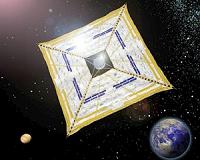 |
Paris, France (SPX) Jul 08, 2010 Astrium has been selected by the European Space Agency (ESA) to undertake initial development studies for a Next Generation Launcher (NGL) for future satellite launches. This 15 month project has a total contractual value of euros 8.5 million, of which Astrium will contribute euros 1.5m of its own funds. "This contract will enable Astrium to investigate the most promising options for the next generation of European launcher in collaboration with nine European countries with past experience of working on the Ariane programme." said Astrium Space Transportation CEO Alain Charmeau as he signed the contract. The NGL project is part of ESA's Future Launcher Preparatory Programme (FLPP), which aims to prepare a proposal combining all the technical and organisational aspects of the programme for presentation at the next ESA ministerial conference. "Astrium is designing, developing and building Ariane launchers." said Alain Charmeau. "So the teams are obviously proud to be asked to contribute their know-how to what will eventually be Europe's future launch vehicle. For some of them, this project will take up a major part of their professional lives. The development of a new launcher involves creating the technologies of tomorrow, whilst minimising development costs and ultimately operating costs. It's the adventure of a lifetime." Europe requires a new launcher to assure continuity and preserve its independent access to space. The study will look towards 2025 for institutional missions covering a performance range from three tonnes into geostationary orbit (including a four tonne segment into sun-synchronous orbit (SSO)) through to eight tonnes. The NGL will be phased in with the Ariane 5ME (Midlife Evolution), an evolved version of Ariane 5 for which a preparatory programme was set in motion during the 2008 ESA ministerial conference. The Ariane 5ME represents a much-needed response to the institutional and commercial markets' requirements for a medium-term launch capacity for heavy satellites in geostationary orbit (with a launch mass of more than 11 tonnes). ESA and Astrium will concentrate on the aspects of the project that will help to improve competitiveness between now and 2025, with special emphasis on reliability, availability and lower costs, in particular operating costs. The study will focus on modular concepts capable of covering the intermediate propulsion power range. The project is divided into three parts: definition of a launcher concept, required technological innovations, and the costs of building and operating the new launch vehicle: + Architectural design studies will be conducted for the launch-vehicle concepts short-listed in the first period of the programme in 2007/2008: The so-called HH concept for a two-stage launch vehicle, in which both the main and upper stages are fuelled by a cryogenic mixture of liquid oxygen and hydrogen. The main, high-thrust engine (HTE) will be based either on the same gas generation technology employed in the Vulcain II or on the more powerful staged combustion technology, which is not yet operational in Europe. The CH concept for a two-stage launch vehicle consisting of a main stage powered by a methane/ liquid oxygen propellant and a cryogenic upper stage. The PPH concept for a three-stage launch vehicle in which a solid propellant is used in the main engine and the second stage and a cryogenic fuel in the upper stage. The cryogenic engine for the upper stage will be a derivative of the Vinci engine developed for the Ariane 5ME. To ensure modularity, the launcher will be equipped with solid-propellant auxiliary boosters. + Innovative technologies will be identified in all relevant areas (propulsion, materials, structures, avionics, pyrotechnics). They will be assessed both in terms of their intrinsic capacity to improve performance and, more especially, from the point of view of cost of ownership and lifecycle considerations. + Cost estimates will be drawn up for each of the proposed concepts, not only for the development phase but also with respect to lifetime exploitation costs.
Share This Article With Planet Earth
Related Links Astrium Space Tourism, Space Transport and Space Exploration News
 Solar Sailing: Pathway To The Stars
Solar Sailing: Pathway To The StarsPasadena CA (SPX) Jul 05, 2010 When it comes to space travel, no propulsion method surpasses the sheer romance of solar sailing, literally flight on light. We invite you to learn of the exciting advances in the field at a free public event on July 21, 2010 - "Solar Sailing: Pathway to the Stars." New York City College of Technology (City Tech) is hosting an International Solar Sailing Symposium from July 20-22 in Brookl ... read more |
|
| The content herein, unless otherwise known to be public domain, are Copyright 1995-2010 - SpaceDaily. AFP and UPI Wire Stories are copyright Agence France-Presse and United Press International. ESA Portal Reports are copyright European Space Agency. All NASA sourced material is public domain. Additional copyrights may apply in whole or part to other bona fide parties. Advertising does not imply endorsement,agreement or approval of any opinions, statements or information provided by SpaceDaily on any Web page published or hosted by SpaceDaily. Privacy Statement |